Tried and tested baking tips on how to strengthen sourdough starter with step by step instructions on how to revive weak sourdough starter.
Your success with sourdough bread baking will depend on your sourdough starter, so today I wanted to share with you what to do if your sourdough starter becomes weak and how to revive it.
I’ve been baking sourdough bread for the last 22 years or so and taught over 10 years (and hundreds of students) Sourdough Bread Baking classes, so these tips have been tried and tested and should work with any type of sourdough starter, including gluten-free sourdough starter.
I should mention, that I mainly bake with regular gluten flours, but occasionally I use gluten-free bread flours to make my bread a little lighter and easier to digest.
SOURDOUGH BREAD BAKING RESOURCES
- How to stop sourdough sticking to proving baskets >>
- Is sourdough bread vegan? >>
- Sourdough starter troubleshooting guide >>
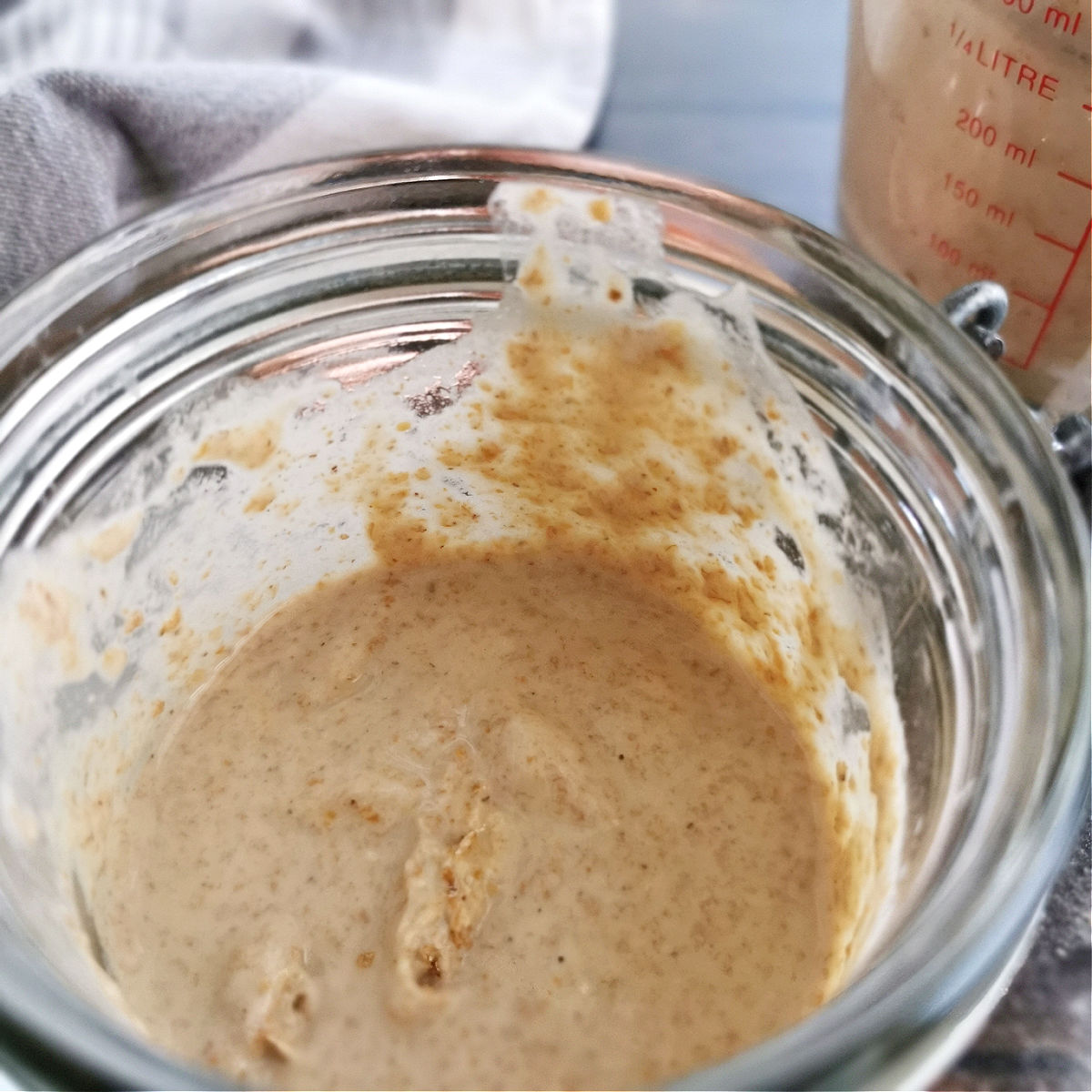
How to tell when your sourdough starter is weak
If you’ve been baking sourdough bread for a while, you know that sourdough bread starter can sometimes get sluggish, become weak or stops growing as quickly as you’d like it to.
Your sourdough starter is very likely to be week if:
- Doesn’t have any or has very few bubbles
- You might see a darker water on the top of the starter separated from the rest
- Doesn’t grow when you feed it with fresh flour and water
- Doesn’t rise the dough when you leave it out
- Rising takes much longer than usual
- Bread doesn’t rise or rise very little in the oven
All of these are signs of a slightly neglected sourdough bread starter, but the good news is that you can easily strengthen the sourdough starter virality and carry on baking your homemade sourdough bread.
How to strengthen sourdough starter – step by step
You’ll find out more about the elements of reviving sourdough starter in my blog post below, but for now, here is the process I always follow if my sourdough starter is completely flat:
- Take out 3 tablespoons of the old weak sourdough starter
- Add 3 tablespoons of rye flour
- Add 3 tablespoons of slightly warm water
- Mix everything together
- Place in a new container
- Depending on how weak my sourdough starter is, I add grapes or use natural full-fat yoghurt instead of water
- Leave the sourdough starter in a room temperature covered with a tea towel
- Check after 4-6 hrs
- Feed again (either using 9 tablespoons of new water and flour if you want to bulk up your sourdough starter or remove some (half) of the sourdough starter and add the same amount of flour and water)
- Check again after 4-6 hrs and repeat if needed
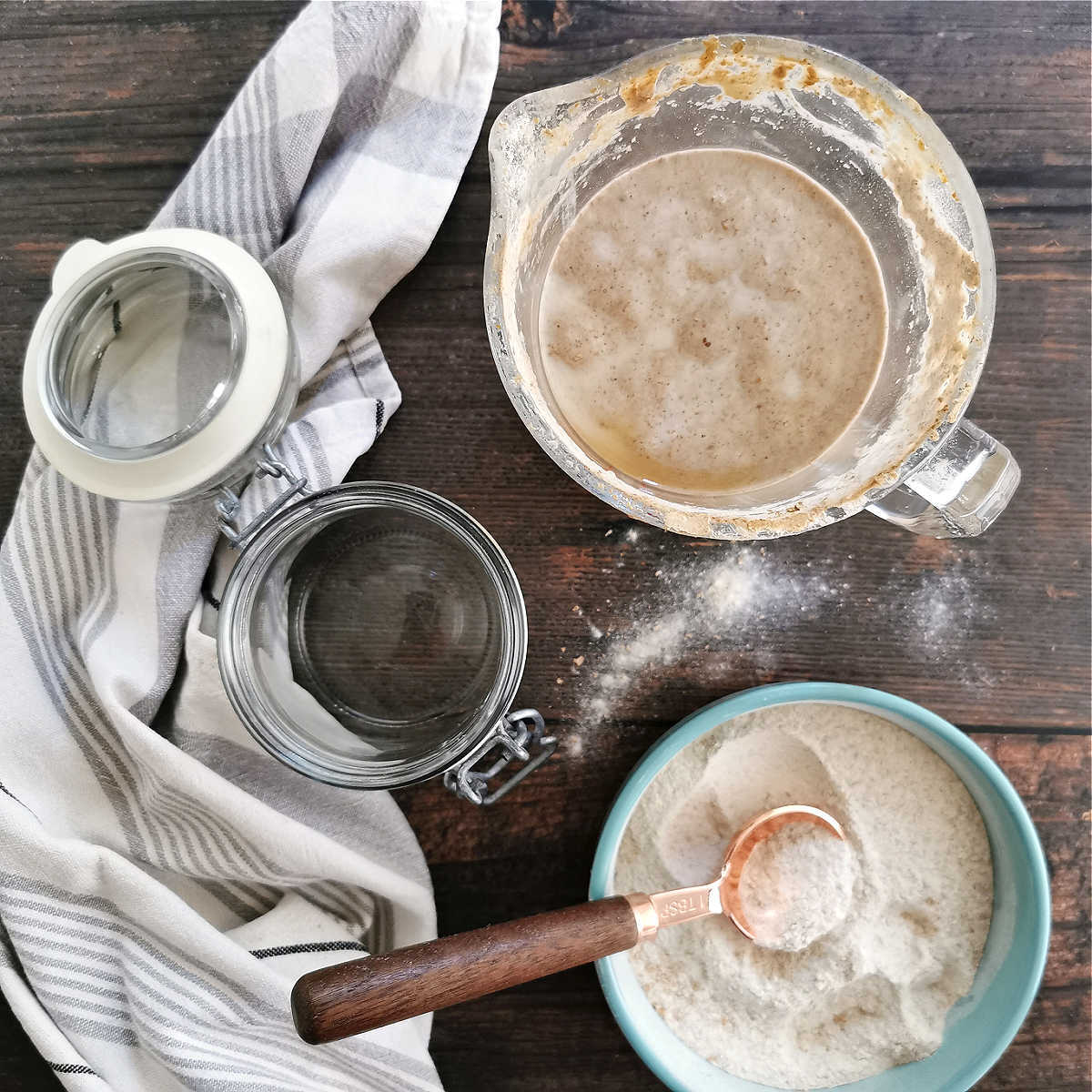
Make sure the environment is right
What works one day, might not work in exactly the same way next week as your kitchen might be a slightly different temperature, you use different bread flour, and the starter is less or more vigorous than the previous week.
- Is sourdough bread easier to digest? >>
- How to stop sourdough starter from developing mould >>
- How to stop sourdough from spreading >>
Use strong wholemeal or rye flour
To make sure your sourdough starter becomes strong again, use coarsely ground type of flours or natural, heritage flours. Coarse bread flour contains bits of husk and outer layers of the grains, which contain extra bacteria that can get the starter bubbling again.
Wholemeal, unbleached or coarsely ground bread flour also has a higher level of minerals and nutrition than for example finely ground white bleached bread flour.
The best type of flour to revive your sourdough starter includes rye, spelt, strong wholemeal, heritage flours, stoneground organic flour or at least unbleached white bread flour.
Whisk your sourdough starter to add oxygen
Using a fork or handheld whisk, mix your sourdough starter to increase the oxygen level in the starter. The extra oxygen contains naturally occurring bacteria from the air and this is what’s going to re-fresh your weak sourdough starter.
When my starter was very limp, I’ve used an electric whisk for a few minutes, and it did the trick.
Even if your sourdough bread starter is absolutely fine, adding extra oxygen by whisking the mixture makes the sourdough stronger and slightly quicker to rise your bread.
Keep the sourdough starter warm
Keep your sourdough starter in a warm environment as it needs at least 23-25 C to get started, but don’t overheat it (which can actually kill it). This could include a sunny windowsill, hot water or boiler cupboard, warmer room or even next (but not touching) to a radiator.
Other options include keeping the sourdough starter in a microwave with the microwave door open, which keeps the light on. This is enough heat to keep the whole sourdough starter nice and cosy. Wrap your sourdough container with a tea towel to prevent any heat loss.
I’ve also known people to use a heating pad to stand their sourdough jar on. These are either the one you buy for tropical animals or for warming up your dinner plates. The heat from these heat pads is close to a body temperature, which is, again, the perfect temperature for sourdough starter.
It’s not a good idea to overheat your starter on regular basis. If you keep your sourdough starter at more than 30C the bacteria will multiply and ferment much quicker, which will make the sourdough starter too acidic. This will change the flavour of your sourdough and it can be difficult to tone down the high acidity to a reasonable level.
SOURDOUGH BREAD BAKING RESOURCES
- Is sourdough bread gluten free? >>
- How to dry sourdough bread starter >>
- The complete guide to freezing sourdough starter >>
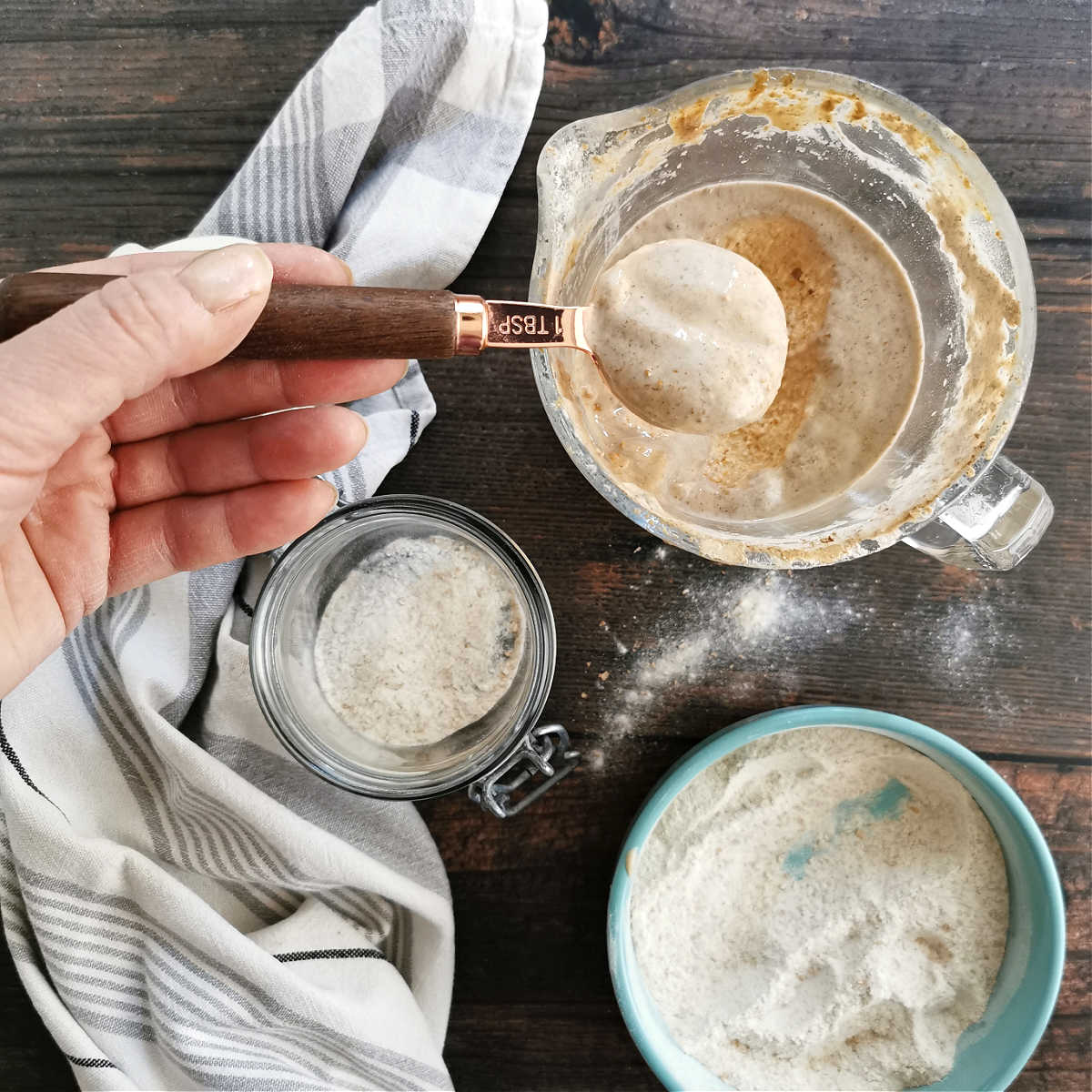
Use the right type of water
If you can, use non-chlorinated water as chlorine can kill your sourdough starter. Use at least filtered water or boil water and leave it to cool down before you use it.
Natural spring water (either real or bottled) will work too especially as it has a high level of iron, magnesium, zinc or other minerals.
Use warm water
Every time you replenish your sourdough starter, make sure you use warm water to help the starter get active quicker.
Be patient!
So, whilst most sourdough recipes tell you that your sourdough starter will be ready in a week, it’s not uncommon to wait until 14 or 21 days before the sourdough starter is vigorous enough to work.
This is because recipes are based on ideal conditions, and as you have probably realised, that’s not always the case!
So, don’t be disappointed if your sourdough starter is not bubbling and ready in seven days, keep at it, and you will be rewarded soon enough!
Don’t forget to feed your sourdough starter
I’m sure that you know that you are meant to ‘feed’ your sourdough starter, but without knowing why, you might not realise how crucial this bit is.
The good bacteria needs to feed on something, which is what’s happening when you add fresh flour and water. You are increasing the number of fresh bacteria and ‘food’ for the existing bacteria to munch on.
Don’t forget to discard about half of your sourdough starter first before a new feed. You can always use the discarded starter to make pancakes or other treats.
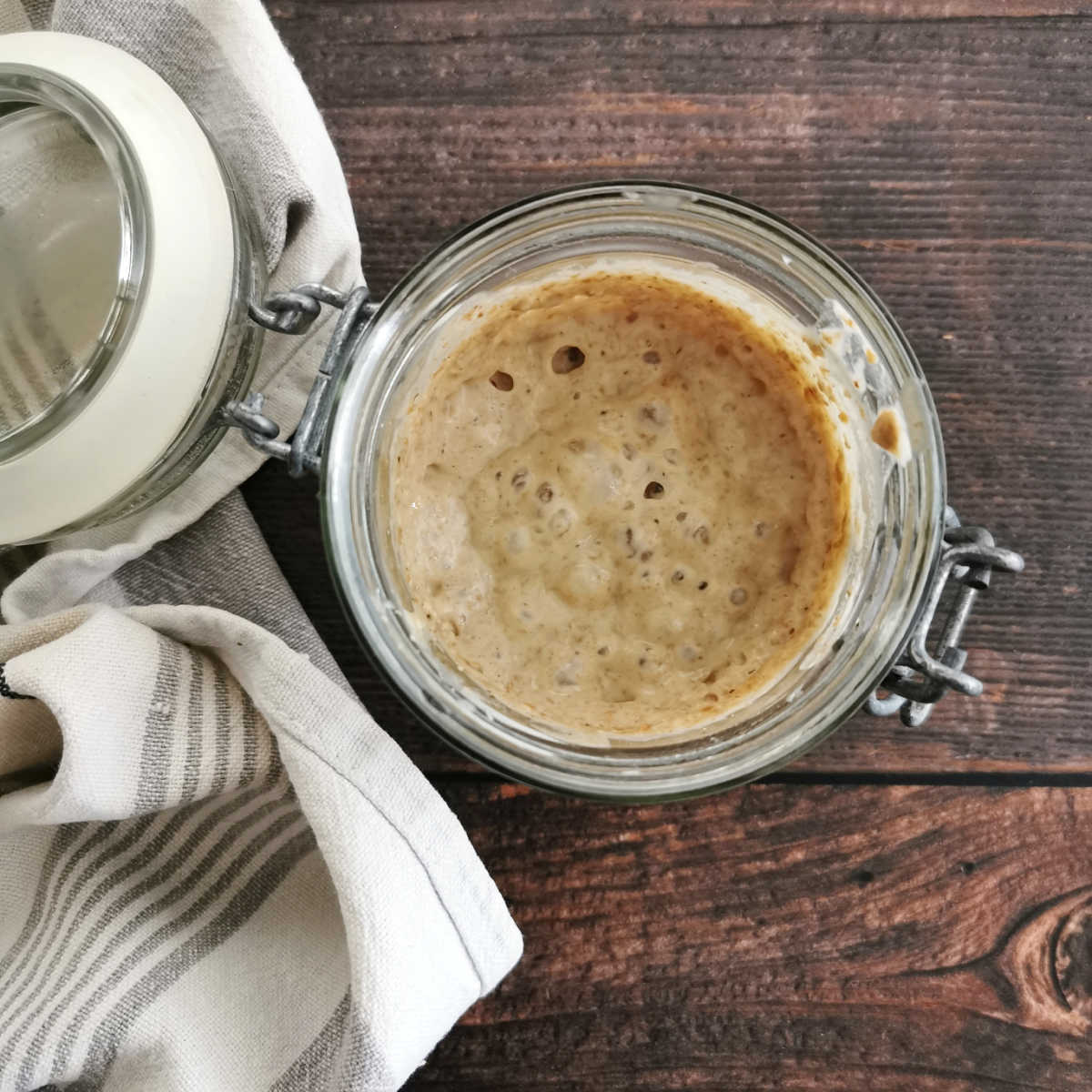
Use other ingredients to help the sourdough starter get underway
- Grapes
- Pineapple
- Orange Juice
- Apple
- White yoghurt
- Full fat milk or cream
- Potato
Use water enriched with potato starch, by boiling a small chopped-up potato until it goes mushy. Strain the water and use it as the water for the next sourdough starter feed. You can also use potato flour with some water instead of mashed potatoes.
Add a few crushed grapes, fresh pineapple, orange or apple juice to increase the acidity of your sourdough starter.
You can also grate a ¼ of an apple and add it to your sourdough starter. Leave it in until it starts to bubble and then either carefully remove it or put the sourdough starter through a sieve.
What to do if your sourdough starter is very week or completely flat
Take out about 3 tablespoons of your sourdough starter, add it to a new container. Add 3 tablespoons of fresh flour (I use wholemeal bread flour or rye flour for best flavour and rising effect) and 3 tablespoons of warm water.
Stir in properly, keep loosely covered somewhere warm (ish) and feed twice a day for the next 2-3 days or until the sourdough starter becomes active again.
Any discarded sourdough can be used for regular bread baking, like making mango breakfast pancakes, making buckwheat savoury crackers or baking delicious brownies or cakes.
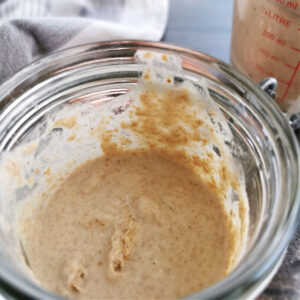
How to strengthen sourdough starter
Equipment
- jam jar or plastic tub clean and with lid
Ingredients
Initial feeding
- 3 tablespoons inactive sourdough starter
- 3 tablespoons bread flour rye, wholemeal or other strong bread flour
- 3 tablespoons water can be slightly warm
Follow up feeding (repeat 2-3 times)
- 3 tablespoons refreshed sourdough starter
- 3 tablespoons bread flour
- 3 tablespoons water
Instructions
- Take out 3 tablespoons of the old weak sourdough starter
- Add 3 tablespoons of rye flour
- Add 3 tablespoons of slightly warm water
- Mix everything togetherPlace in a new container
- Depending on how weak my sourdough starter is, I add grapes or use natural full-fat yoghurt instead of water
- Leave the sourdough starter in a room temperature covered with a tea towel
- Check after 4-6 hrs
- Feed again (either using 9 tablespoons of new water and flour if you want to bulk up your sourdough starter or remove some (half) of the sourdough starter and add the same amount of flour and water)
- Check again after 4-6 hrs and repeat if needed







Leave a Reply